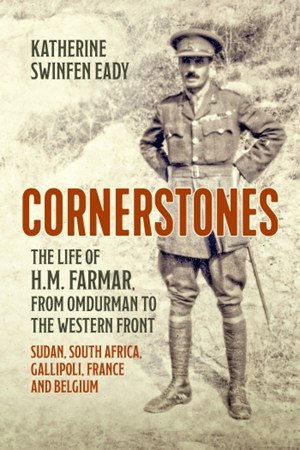CORNERSTONES
The Life of H. M. Farmar, From Omdurman to the Western Front
Author: Katherine Swinfen Eady
Publisher: Helion & Company, 582pages, 20 b/w photos, 7 maps
Published: February 2019
Price: £29.95
ISBN: 9781910777435
I found the book enthralling in many parts, especially the pages covering the preparations and the actual landings, mainly because I had recently read the private diary of Captain C. A. Bolton, GHQ Liaison Officer, who was stationed on W beach at the time Farmar was in the Helles Lighthouse. It became apparent that it was Bolton that Farmar’s runners were taking their messages to, although at the time neither appeared to know of each other’s existence. Bolton wrote that following the wounding of Brigadier Hare and death of the Brigade Major Frankland, 86 Brigade had no remaining staff, an interesting statement that makes no mention of Farmar who had taken over as brigade major and had established Brigade HQ, as ordered, at the Lighthouse. Confusion reigned that day of the landing, so it is not surprising that accounts differ, but it was staff officers like Farmar and Bolton who were to a large extent preventing a bad situation getting any worse.
The story of Harold Mynors Farmar, written by his great granddaughter, Katherine Swinfen Eady, is the result of several years of painstaking and meticulous research following the discovery of over 700 of Mynors letters to his wife, Violet. The uncensored detail makes a fascinating insight in to a staff officer’s war. The letters are cleverly weaved by the author into a very readable narrative that not only fills some gaps in the W beach story, but also challenges the common story that many of us are familiar with. Whilst there is a plethora of written works on the Gallipoli landings already, Mynors unpublished letters adds valuable information to help defuse the confusion of the 29th Division’s landing that fateful day. This staff captain was not only present, but to a large degree was running 86 Brigade HQ for the majority of the action due to senior officer casualties that day. Mynors, although credited for this action, probably didn’t receive as much credit as he deserved.
The lost opportunity at Y beach is mentioned by the author, of interest because it may have been a signal that originated from Mynors that gave the impression that the covering forces that had landed on Y and X beach had linked up. Did Hunter-Weston ignore these landings because he thought his left flank was secure? Was his fixation with making right the landings of W and V beaches a case of reinforcing failure instead of exploiting success elsewhere? Through the letters and the authors narrative this is something we can leave to the reader to decide.
Mynors comes across in his letters as level headed and calm under pressure, but he doesn’t shy away from noting others who had cracked under the pressure. The collapse of command and control at Gallipoli is a major contributing factor to the MEF’s defeat, and having this insiders view makes fascinating reading. Although a first-rate staff officer, the MEF were far from being a first rate army. Regardless of individuals skill and experience, the British Army of 1915 was still very much at the bottom of the learning curve. Mynors was determined to ensure that lessons needed to be learnt from the failure of the campaign, something he put into practice in his other posts, through his ability as a natural mentor and a very capable professional soldier and staff officer. Reading the letters it sounds like we needed more Mynors at Gallipoli.
After Gallipoli Mynors was posted to General Sir John Monash’s staff of 3rd Australian Division, where he helped with training and the actions of Messines and the Third Battle of Ypres. By 1918 he was with the 35th Division, and then he taught at the newly established US Army Staff College in France before his wealth of knowledge and experience was called for by IX Corps just before the Armistice. Post-war he worked with the Inter-Allied Command in Turkey which gave him the opportunity to revisit Gallipoli, a place that had a profound effect on Mynors, not surprising as it was a place where he had lost so many of his closest friends. Cornerstones is a fascinating book, an insight into the life of a clearly competent and experienced staff officer, a ‘cornerstone’ of the British Army. Thoroughly recommended.
Purchase via Helion: https://www.helion.co.uk/military-history-books/cornerstones-the-life-of-h-m-farmar-from-omdurman-to-the-western-front-sudan-south-africa-gallipoli-france-and-belgium.php
Purchase via Amazon: https://www.amazon.co.uk/Cornerstones-Omdurman-Western-Gallipoli-Belgium/dp/1910777439/ref=sr_1_1?keywords=cornerstones+eady&qid=1585436654&sr=8-1


